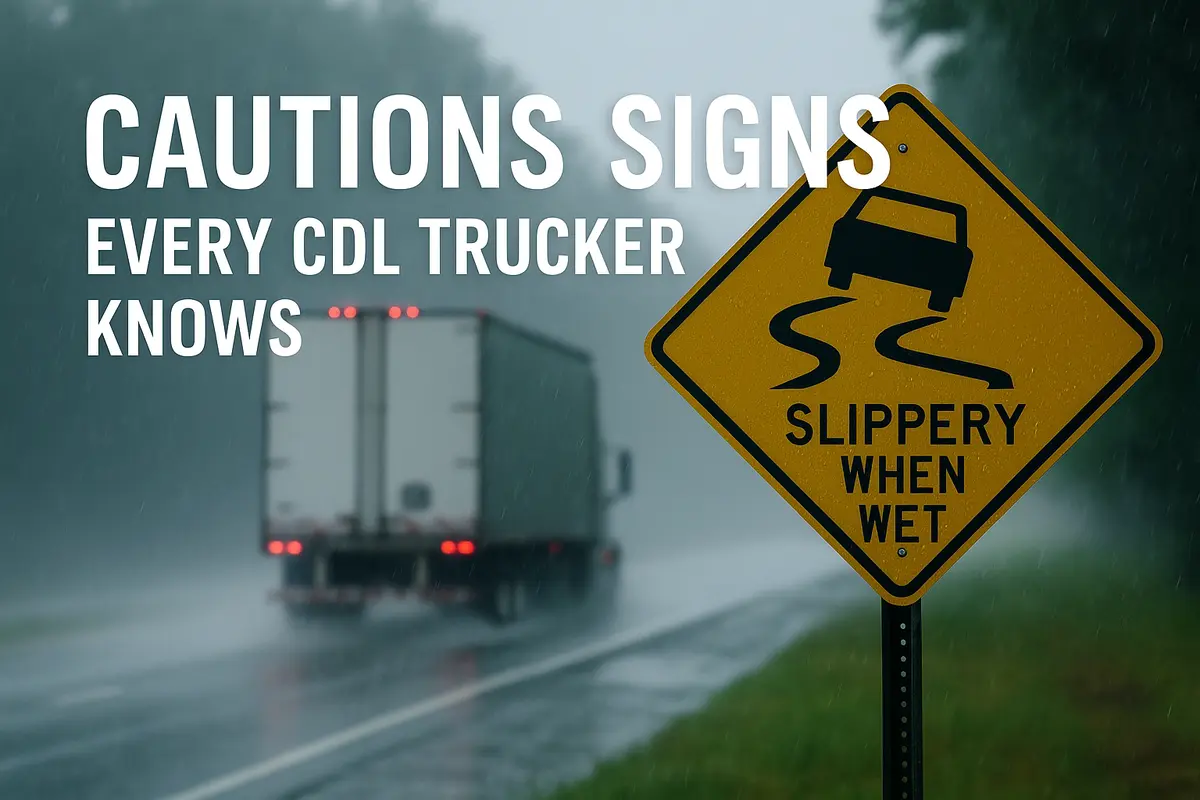In the world of trucking, seconds matter—and so do signs. For CDL drivers navigating highways, city roads, construction zones, and unfamiliar territory, caution signs aren’t just guidelines—they’re survival tools. These bright warnings alert drivers to danger, changes in the road, and areas where heightened awareness is not optional, but essential.
For CDL managers, consultants, and fleet owners, this isn’t just a driving school lesson. It’s a compliance priority. Whether onboarding a new hire or requalifying a long-time driver, ensuring your team knows the caution signs on the road can prevent crashes, save lives, and avoid costly violations.
At Drivers Files Online, we make it easy to build a safety-first fleet with digital tools that support onboarding, compliance tracking, and driver file management.
👉 Want to train smarter and track safer? Set up Drivers Files Online today.
Why Caution Signs Deserve a Place in Every Driver File
Understanding caution signs is more than just passing a permit test. It’s about maintaining situational awareness, ensuring regulatory compliance, and navigating safely in high-risk areas.
That’s why every CDL onboarding program should include a refresher on road signage, with a focus on:
- New hires from different states
- Returning drivers re-entering the field
- International drivers navigating U.S. highways
Fleet owners who use Drivers Files Online’s online driver application system can upload onboarding materials and sign-off documents that verify sign review was completed—making it easier to prove your training is thorough and FMCSA-aligned.
What Does a Caution Sign Mean?
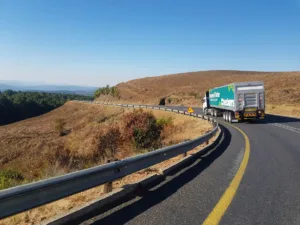
A caution sign, typically a caution sign yellow diamond with black symbols or words, signals a change in road conditions or hazards ahead. Common examples include:
- Curves and winding roads
- Steep grades or downgrades
- Pedestrian crossings
- Narrow bridges
- Slippery when wet zones
The caution sign meaning is simple: be alert, slow down, and expect change.
According to the Manual on Uniform Traffic Control Devices, all caution traffic signs follow specific design and placement standards to ensure national consistency. This makes it easier for CDL drivers to anticipate risks—especially when tired or operating in unfamiliar regions.
Key Caution Signs CDL Drivers Must Know
Let’s break down the most important caution signs for CDL drivers, all found in the MUTCD’s standardized sign system.
⚠️ Slippery When Wet
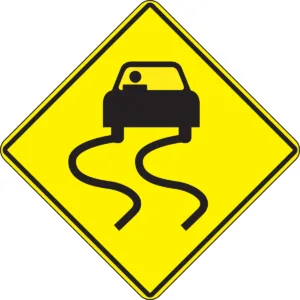
Appears as a yellow diamond with a car and wavy tire tracks.
Why it matters: Heavy trucks need far more distance to stop. This sign warns of low-friction conditions like rain, ice, or oil spills.
⚠️ Merge Ahead

This caution traffic sign shows two lanes becoming one.
Why it matters: Trucks need more space to merge. Failing to anticipate lane reduction can cause last-minute, unsafe shifts.
⚠️ Steep Hill / Downgrade
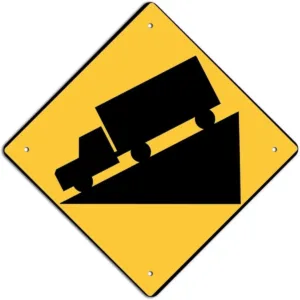
Typically a truck icon rolling down a slope.
Why it matters: CDL drivers must gear down early and use proper braking technique. Poor downgrade handling can result in brake failure or rollovers.
Tie this into your fleet’s training with posts like CDL hazmat test prep, which covers signage and placards for hazardous materials—often paired with downgrade zones for route planning.
⚠️ Lane Ends
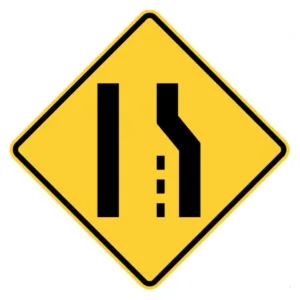
Indicates a lane is disappearing up ahead.
Why it matters: Trucks must merge early to avoid last-minute lane changes, especially in heavy traffic or narrow work zones.
Why Fleet Owners Should Reinforce Caution Sign Knowledge

A driver who misunderstands a caution road sign isn’t just a risk to themselves—they’re a liability to your business. Failing to yield, merge properly, or slow down can result in:
- DOT citations
- Insurance claims
- Accidents and injuries
- Lost contracts or freight delays
That’s why our platform includes tools to proactively manage knowledge gaps. With Drivers Files Online, you can:
- Log sign training during onboarding
- Upload safety quizzes and driver acknowledgements
- Receive alerts for refresher deadlines
- Store compliance docs to protect your business in the event of a claim or audit
Need to review your files for completeness? Our Managed Services team helps ensure every driver application includes updated safety training records—so nothing falls through the cracks.
More Cautions Signs for CDL Drivers to Know
It’s never a bad idea to study up on things you might have forgotten about. From Youtube user SmartDriveTest, here are 11 caution road signs that should always be fresh on your drivers’ memories!
Pass With Caution Sign: More Than Just Words
The pass with caution sign seems straightforward, but its misinterpretation can be fatal. It typically indicates a zone where passing is allowed but only under strict conditions—clear visibility, safe speed, and no oncoming traffic.
For CDL trucks, “passing” isn’t just about lane changes. It involves speed, braking distance, and trailer swing. Failing to heed this sign in a construction or downgrade area can result in violations or loss of control.
Use it as a case study during onboarding—one that aligns with other important skills like parking a semi truck safely, merging techniques, and emergency maneuvers.
How to Track Road Sign Compliance Digitally

Modern fleets need digital records—not just for audits, but to build trust with clients and DOT inspectors. With Drivers Files Online, you can:
- Digitize driver road sign training
- Store inspection histories tied to caution traffic signs like yield failures
- Review PSP data with our DOT PSP Reports feature
- Verify state-by-state MVRs to ensure all drivers are properly licensed and trained using our State MVR Reports tool
🧾 Looking to scale your safety program and cut through the paperwork? View pricing options here.
Make Caution the Core of CDL Compliance 🚧

Understanding caution signs isn’t just a box to check on the permit test—it’s a real-world skill that protects people, cargo, and companies every day. For CDL drivers, the ability to read and respond to caution road signs can mean the difference between a smooth route and a roadside emergency.
For fleet owners and consultants, now is the time to formalize this training. Make caution sign reviews part of every new hire’s file, every safety meeting, and every compliance review.
And when you’re ready to document it all in one place, Drivers Files Online is here to help.
🚛 Support smarter onboarding and safer driving—get started now with Drivers Files Online.
Frequently Asked Questions About Caution Signs for CDL
What is a caution sign?
A caution sign is a yellow diamond-shaped traffic sign used to alert drivers to potential hazards, changes in the road, or upcoming conditions.
What does a caution sign mean while driving?
It means “slow down, stay alert, and be prepared to change lanes or reduce speed.” These signs are common near construction zones, merges, and hazardous curves.
Why is the caution sign yellow?
The caution sign yellow color is highly visible and universally associated with warning or danger across U.S. roads.
What are some examples of caution signs on the road?
Merge ahead, slippery when wet, lane ends, and steep downgrade signs are all examples of caution signs designed to warn commercial and non-commercial drivers.
How can fleets track caution sign training?
Fleets can use Drivers Files Online to store training docs, inspection data, PSP history, and driver acknowledgements all in one digital platform.
Disclaimer: This article is for informational purposes only and does not constitute legal or regulatory advice. For official traffic sign standards, please refer to the FHWA’s Manual on Uniform Traffic Control Devices or consult your state’s commercial licensing authority. For driving safety tips, see the FMCSA’s official safety guidance.
